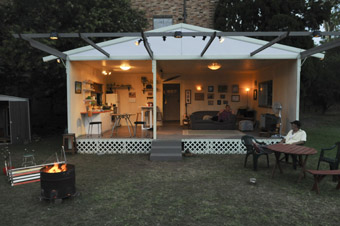home is where the hurt is
caroline wake: urban theatre projects, the fence, sydney festival

Helen Dallas, Richard Green, The Fence, UTP
photo Heidrun Löhr
Helen Dallas, Richard Green, The Fence, UTP
IN ORDER TO GET TO THE FENCE, WE HAVE TO TRAVERSE A FEW OURSELVES. STARTING AT PARRAMATTA RIVERSIDE THEATRE, WE WALK UNDER THE BRIDGE, ACROSS THE LAWN AND THROUGH A TUNNEL BEFORE WAITING ALONGSIDE A WIRE FENCE TO ENTER THE WIDER ENCLOSURE WITHIN.
Once in, we apply insect repellent, purchase programs and then wait at another fence on the other side. From here we walk up a wooden ramp before taking our seats in the red raked bleachers. Below is Alison Page’s meticulous set: the back half of a suburban house without its fourth wall. Inside there is a couch with cushions, two tasteful lamps, a wall of framed pictures, a stereo, a television, and a kitchen where a woman is cooking. Outside there is a shed, a steel drum and a wooden table with three green plastic chairs.
Soon enough the cook—Joy (Skye Quill)—announces that dinner is ready. She and her indigenous partner Mel (Kelton Pell) settle down on the couch but they are interrupted when a teary Lou (Helen Dallas) emerges from the bedroom, phone in hand and fresh from another break-up. Mel’s friend Chris (Richard Green) cruises in looking for a feed and throughout all of this, someone travelling suspiciously light lurks outside. The phone rings, Mel picks up and a voice says, “You took long enough.” Standing in the backyard, the intruder turns out to be Mel’s sister Connie (Vicki Van Hout), whom he hasn’t seen for ten years.
Thus the scene is set for a night of reunion, remembrance and occasional disagreement. Characters drift in and out of the house and through a series of elliptical conversations. Sometimes there are two conversations going on at once, such as when director Alicia Talbot, master of the split stage, places Lou and Connie inside while Mel and Chris converse outside. Then Joy, who apparently has a history with Connie, re-emerges to reprimand Chris for not being at home and Mel for not being inside talking to his sister. Lou breezes by, asking airily if she’s interrupting anything and everyone dances languidly around the living room to Steve Miller’s “The Joker.” (Liberty Kerr’s sound design and song choice are excellent throughout.) Lou cheers up and announces that she’s going out: “I’m going to find a man.” “I’m going to watch her find that man”, says Connie. “Maybe I’ll go too”, muses Joy but the moment passes before they get out the door.
The men retreat to the shed and the women’s conversation turns to children, biology as destiny and the perils of population growth. Once again we seem to be talking around something rather than about it until the conversation seems to slide out of anyone’s control. Suddenly Joy is goading Connie: “I turned out okay; you’re pretty fucked up though;” Connie is replying, “Don’t speak for me, my mother loved me. Number 184 doesn’t need a mouthpiece”, and Joy is threatening to throw her out of the house. It sounds explosive, but it isn’t—it’s just a conversation gone unexpectedly awry. When Connie goes outside to confess to her brother that she and Joy have had a blue, she says simply. “Ten years come and gone in one fell swoop.”
The Fence chronicles a night, and through it a lifetime, of loss, survival and reconciliation. Like The Cement Garage (2000), The Longest Night (2002), Back Home (2006) and The Last Highway (2008) before it, this show has been devised in collaboration with community consultants around a large contemporary theme: in this case institutional care as experienced by both the Stolen Generations and the Forgotten Australians. Once again, Talbot has created a piece of neo-naturalistic theatre in a non-traditional theatre space. This time, however, the usual magic is missing and the historic site—on the lands of the Burramattagal and Wallumattagal people, near the former Parramatta Girls Home, and the former site of the King’s School—seems to work at cross purposes to the set. Whereas the site functions to blur the line between theatre and reality, the kitchen-sink set serves to reinforce it: this isn’t a real house, it’s a really good re-creation of a house and it would make almost as much sense in a theatre as it does here.
Nevertheless, there is a tangible sense of intimacy within it, thanks to the understated performance of the cast. Like his character, Pell provides an anchoring presence while Quill is both brittle and vulnerable as his partner and Green is suitably restrained as his taciturn friend. Similarly Van Hout is lean and slightly nervy as the evasive Connie and Helen Dallas is a voluptuous and vivacious Lou. Through this improvised family The Fence makes visible what many of us take for granted: the minor miracle of everyday life. The performance ends with Connie walking off into the night and Mel placing leaves in the burning drum, creating a smoking ceremony of sorts. Home is where the hurt is, the hearth is, and—when we are lucky—the heart is.
–
2009 Sydney Festival, Urban Theatre Projects, The Fence, direction and original concept Alicia Talbot, performers and co-devisors Helen Dallas, Richard Green, Kelton Pell, Skye Quill, Vicki Van Hout, set design Alison Page, lighting design Neil Simpson, sound design Liberty Kerr, community liaison Lina Katsoumis; Parramatta, Sydney, Jan 14-30
RealTime issue #95 Feb-March 2010 pg. 16






